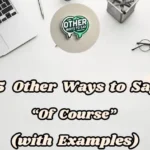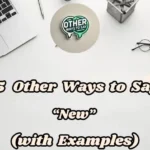The word “something” is a go-to, but it can be a bit vague. To make your writing more precise and engaging, it’s smart to explore alternatives. By choosing a more specific word, you can add detail and impact to your message. Below, you’ll find 15 options for other ways to say “something,” each with its own unique feel and purpose.
What Can I Say Instead of Something?
- Thing
- Item
- Object
- Stuff
- Matter
- Entity
- Article
- Piece
- Element
- Aspect
- Feature
- Detail
- Factor
- Bit
- Unit
1. Thing
Thing is the most common and versatile substitute for “something.” It’s a broad, general term that can refer to any object, idea, or situation. Its tone is casual and conversational, making it perfect for everyday chats or informal writing where specificity isn’t important. Using things feels natural and approachable, keeping your language light and flexible.
- Example 1: “Bring that warm thing you wore last winter; it gets cold at night.”
- Example 2: “That new app idea is a cool thing to explore with the team.”
2. Item
An item refers to a specific, single object, especially one that’s part of a larger list or collection. It has a precise and slightly formal tone, which is great for professional contexts like shopping, inventory management, or reports. By using an item, you’re clearly highlighting a distinct, tangible entity.
- Example 1: “Add a fresh item like avocados to your grocery list.”
- Example 2: “Make sure to include that budget item in the final report draft.”
3. Object
Object is a neutral term for a physical, tangible entity. Its tone is often technical or descriptive, making it suitable for scientific studies, inventories, or any context where you need to refer to a concrete thing without emotional nuance. It’s perfect when you want to be clear and objective about a physical presence.
- Example 1: “That shiny object looks like an old coin on the ground.”
- Example 2: “Place that large object in the center of the display for better visibility.”
4. Stuff
Stuff is a casual, informal word for a collection of things, ideas, or materials. It’s perfect for laid-back conversations because it’s vague and doesn’t require you to list every single item. Using stuff makes your tone feel breezy and friendly, suggesting a lack of formality.
- Example 1: “Pack all that stuff in the closet first; it’s the messiest.”
- Example 2: “I’ve got some fun stuff lined up for the weekend!”
5. Matter
Matter is a term for a significant issue or topic, often used in serious discussions. It has a formal and thoughtful tone, which is fitting for professional meetings or important debates. When you use matter, you’re emphasizing the gravity and relevance of the topic.
- Example 1: “That matter sounds serious; we should talk it through later.”
- Example 2: “This urgent matter needs our immediate attention.”
Related Post: 15 Other Ways to Say Of Course (With Examples)
6. Entity
An entity refers to a distinct, independent unit, which could be a business, a concept, or a being. It has a formal, technical tone that makes it ideal for academic or professional settings. Using entity highlights the standalone nature or identity of what you’re discussing.
- Example 1: “That new entity has a strong brand identity that stands out.”
- Example 2: “Our analysis shows this entity dominates the local market.”
7. Article
An article refers to a specific item, particularly a written piece or a tangible good. Its tone is formal and precise, making it great for journalism, retail, or cataloging. Using an article brings a sense of specificity and clarity to a single, defined item.
- Example 1: “That trendy article looks perfect for your style; you should try it on.”
- Example 2: “The editor wants to make sure this article has a catchy headline.”
8. Piece
A piece describes a single part or unit of a larger whole, like a piece of art or a component of a project. It has a versatile and conversational tone, fitting both creative and casual contexts. Using pieces highlights the individuality of an item or its role within a bigger picture.
- Example 1: “This pottery piece you made is absolutely stunning.”
- Example 2: “That puzzle piece fits perfectly in the design.”
9. Element
An element conveys something as a fundamental or essential part of a larger system or plan. It has a precise and slightly formal tone, which is useful for technical, creative, or analytical discussions. Using an element emphasizes the critical role a component plays in a whole.
- Example 1: “Music is a key element for creating a great party vibe.”
- Example 2: “This new design element significantly enhances the user experience.”
10. Aspect
Aspect refers to a particular feature or angle of a situation, idea, or object. It has an intellectual and analytical tone, perfect for reviews, discussions, or academic settings. Using an aspect helps you focus on a specific perspective or facet of a topic.
- Example 1: “That aspect of the book’s plot was truly intriguing.”
- Example 2: “This specific aspect of the project plan needs further refinement.”
Related Post: 15 Other Ways to Say So (With Examples)
11. Feature
Feature describes a prominent or distinctive characteristic, often with a positive tone. It’s a professional and versatile word, great for marketing, design, or casual conversation. When you use the feature, you are highlighting a notable or appealing trait with enthusiasm.
- Example 1: “That incredible feature is what makes the camera top-notch.”
- Example 2: “This new feature is what sets our product apart from competitors.”
12. Detail
Detail conveys a specific, often small, part of a larger whole, such as a fact in a report or an element in a story. It has a precise and analytical tone, making it ideal for contexts where accuracy and specifics matter. Using detail emphasizes the importance of a particular fine point.
- Example 1: “That small detail you added gives so much depth to the character.”
- Example 2: “This specific detail about the costs significantly strengthens our argument.”
13. Factor
A factor refers to a contributing cause or influence within a situation. It has a formal and analytical tone, making it perfect for business, science, or strategic discussions where you’re analyzing cause and effect. Using factor highlights a key influence that affects an outcome.
- Example 1: “Salary is a major factor to consider when accepting a new job.”
- Example 2: “The unexpected delays were a key factor that slowed our progress.”
14. Bit
Bit describes a small or minor part, often with a casual and informal tone. It’s a lighthearted word, perfect for everyday chats. Using a bit can make a conversation feel playful and minimal, suggesting a small but noteworthy element.
- Example 1: “That little bit of news is quite surprising, isn’t it?”
- Example 2: “This last bit of clutter on the desk needs to go.”
15. Unit
Unit conveys something as a single, distinct entity, especially within a larger group or system. It has a formal and technical tone, suitable for business, manufacturing, or academic settings where precision is key. Using a unit emphasizes the individuality of an item within a collective framework.
- Example 1: “That furniture unit would fit perfectly in the corner of your room.”
- Example 2: “This particular unit is ready to be shipped out today.”
Conclusion
In short, finding other ways to say “something” is a crucial step in elevating your writing. By using more specific and nuanced vocabulary, you can transform a vague sentence into a clear, powerful message.
This ability to choose the perfect word not only makes your work more professional but also leaves a lasting impression on your readers. To continue your journey of discovering a rich vocabulary, visit Other Way to Say and enrich your word bank today.

Thomas Schneider is a language enthusiast and expert in synonyms, dedicated to exploring the beauty of words and their nuanced meanings. With a passion for linguistics and clear communication, Thomas helps readers enrich their vocabulary and understand the subtle art of word choice. Whether you’re a writer, student, or language lover, his insights offer practical tools to elevate your language skills.



Pingback: 15 Other Ways to Say "For Example In An Essay" (With Examples) - Other Ways To Say